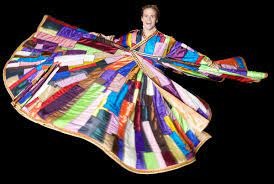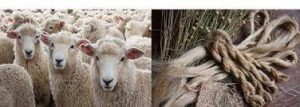Miketz 2021: Clothing, Dreams & Visions
by devadmin | December 2, 2021 8:03 pm
Raboyseyee and Ladies,
Clothing, Dreams & Visions:
 In last week’s parsha, the brothers were riding high; they concocted and executed a plan to rid themselves of the brother they despised. By the end of the parsha, Yoisef had hit bottom and was imprisoned. Welcome to Parshas Miketz, also shabbis Chanukah. It’s 12 years later -so says Rashi- and Yoisef has, after interpreting two of Paroy’s dreams to his satisfaction, had a meteoric rise and reversal of fortune. And how are the holy bothers faring? Not so well. By the time our parsha comes to an end, Yoisef is riding higher than ever while the fortunes of the brothers have fallen precipitously. They have become increasingly embroiled in the consequences of their actions towards Yoisef and in a very difficult situation when Yoisef’s becher (goblet) is discovered in Binyomin’s sack. They understand that Binyomin will now not -despite a personal guarantee given by Yehudah- be able to return with them to their father in Eretz K’nan, and they cannot imagine how their father, and they themselves, will survive this terrible blow.
In last week’s parsha, the brothers were riding high; they concocted and executed a plan to rid themselves of the brother they despised. By the end of the parsha, Yoisef had hit bottom and was imprisoned. Welcome to Parshas Miketz, also shabbis Chanukah. It’s 12 years later -so says Rashi- and Yoisef has, after interpreting two of Paroy’s dreams to his satisfaction, had a meteoric rise and reversal of fortune. And how are the holy bothers faring? Not so well. By the time our parsha comes to an end, Yoisef is riding higher than ever while the fortunes of the brothers have fallen precipitously. They have become increasingly embroiled in the consequences of their actions towards Yoisef and in a very difficult situation when Yoisef’s becher (goblet) is discovered in Binyomin’s sack. They understand that Binyomin will now not -despite a personal guarantee given by Yehudah- be able to return with them to their father in Eretz K’nan, and they cannot imagine how their father, and they themselves, will survive this terrible blow.

Parshas Miketz opens with Paroy’s mysterious chaloimis (dreams) whose meanings eluded his royal advisors ober not our hero Yoisef, who aside from being a dreamer himself, has suddenly added dream interpreter to his resume. Yoisef seemingly acquired a new skill while in prison; others have followed suit while away, if you chap. More on dreams and dreamers below.
Let’s do a quick overview of the entire parsha. Paroy has two dreams. His newly re-instated wine steward, finally -two years later- remembers Yoisef and tells Paroy about Yoisef’s mastery as a dream interpreter. Yoisef is instantly released, gets a shave, haircut, new clothing and does a masterful job of deciphering Paroy’s dreams.
Yoisef’s new clothing and his wardrobe in general, specifically his shirt (or tunic), is of interest to the RBSO, and his many changes of attire -at least some against his will- are specifically delineated in the text of the heylige Toirah. Why such detail? What role if any, did clothing play in Yoisef’s? His clothing deserve attention and let us begin there. In last week’s parsha (Vayeshiv 37:3) we read this:
“Now Israel loved Yoisef best of all his sons, for he was the child of his old age; and he had made him an ornamented tunic.”
Mamish 20 pisukim later, Yoisef found himself tunic-less as we read in posik 23, azoy: “When Yoisef came up to his brothers, they stripped Yoisef of his tunic, the ornamented tunic that he was wearing.”
Raboyseyee, the heylige Ois, after reading this story for the 100th time, has finally seen the light: Yoisef’s clothing play a central role in his life, for both good and bad. Lommer lernin. His first brush with trouble seems to be over the Kisoines Passim (multi-colored coat or tunic) his father hand-made and presented to him. What the hec was this kesoines Pasim? What did it look like? Says Rashi (here and here) that it was a fine woolen garment, ober he also quotes the medrish (Bereishis Rabbah 84:8) which tells us that the letters of the word passim -פסים- tells us all we need to know about Yoisef’s travails with each letter representing another group who purchased and then either traded or owned him. Let’s recall that he was sold (not in any order) to Potiphar (פּוֹטִפַר), to the merchants (סוֹחֲרִים), to the Ishmaelites (יִשְׁמְעִאלִים), and to the Midianites (מִדְיָנִים).
ומדרש אגדה
על שם צרותיו שנמכר לפוטיפר ולסוחרים ולישמעאלים ולמדינים:
Ober, what was it? Many opine but the bottom-line consensus is that it was a colorful, likely embroidered, striped or illustrated shirt, or tunic, made of fine wool (Rashi) or silk. Which was it? Ver veyst? According to some, it was a full-sleeved robe, or coat of many colors, a coat reaching to his feet, an ornamented tunic, a silk robe, or a fine woolen cloak. Got that? The bottom line: the passim is in allusion to his misfortunes; a regular white shabbis shirt might have been a safer gift!

According to some, even the most basic aspects of a garment, may evoke very strong – to include violent- reactions. Mamish? Says the heylige Gemora (Berochis 20A) azoy: one sage was so incensed to see a certain woman wearing a dress he deemed forbidden that he ripped it right off of her, say it’s not so but so the heylige Gemora tells us. Let’s read that shtikel verbatim. “Abaya said to Rav Pappa: The previous generations were wholly dedicated to the sanctification of God’s name, while we are not as dedicated to the sanctification of God’s name. Like this incident involving Rav Adda bar Ahava who saw a non-Jewish woman who was wearing a garment made of a forbidden mixture of wool and linen [karbalta] in the marketplace. Since he thought that she was Jewish, he stood and ripped it from her. It was then divulged that she was a non-Jew and he was taken to court due to the shame that he caused her, and they assessed the payment for the shame that he caused her at four hundred zuz.” Who knew that clothing could evoke such strong emotions? Veyter.

Sold into slavery, Yoisef wound up in the house of Potiphar, the minuvil, but was well liked. We read that Mrs. Potiphar liked him too. Yoisef rose to power in the house of his Egyptian master. His extreme beauty attracted the unwanted advances of his master’s wife. Enraged by his rejection, she accused Yoisef of attempting to seduce her -what else is new-and Yoisef was put away. Says one Medrish that Mrs. Potiphar may have set her eyes on Yoisef davka because he was epes pre-occupied with his own appearance and she became uncontrollably attracted to him. Ober this time, to avoid her advances, he left his shirt behind and ran outside. She yelled rape, and shoin, Yoisef soon found himself locked up for an extended period of time. Once again, the shirt got him into trouble. Let’s read posik 39:12 as the heylige Toirah describes how Yoisef’s garment was again stripped away, this time by the seductress wife known only as Mrs. Potiphar. “She caught hold of him by his garment and said, “Lie with me!” But he left his garment in her hand and got away and fled outside.”
The word “garment” is repeated six times for emphasis. Potiphar’s wife held his garment in her hand with accusations of him trying to seduce her, when in reality he was but fleeing from her sexual advances. Ober while the text explicitly states that he refused her advances, our good Rabbis entertained the possibility that Yoisef ‘asked for it’ and that he was more than tempted. A few go so far as to say he had already taken off his clothes before the image of his tata (father) Yaakov appeared to him making him reconsider. An image of one’s father just as one is about to enjoy a sex act with the boss’s wife is zicher not a mood enhancer.
The heylige Toirah does tell us that he was very good looking. On a basic level, this was an incredible temptation for any person to withstand; could you? The posik says: And it was on that day, that he entered the house to do his work (referring to Yoisef). Says Rashi, quoting the heylige Gemora, azoy: there are two opinions as to what the word ‘work’ refers to. Rav translates it literally, Yoisef showed up for work as he did every day. Shmuel says no: it means that he had entered and conceded to have sex with her, say it’s not so. Rebbe Yoichanan says ‘all the preliminary steps to the act of adultery had already been taken.’ What those steps were, ver veyst, as we are not told. And what happened? Says the heylige Gemora (Soita 36b), that an image of his father appeared before him and he didn’t commit the act. Efsher you’re wondering how Yoisef could even contemplate such a heinous transgression, and the answer is quite simple. when you work closely daily with the boss’s wife and she’s a shiksa, the yetzer horo (evil inclination) will surely stand up and make his move; it’s quite elementary.
Says Rashi, and who knew more or better, azoy: Mrs. Potiphar acted le’shaim shomayim (for the sake of heaven), her intentions were pure. Pure what? Seemingly, she saw through her astrological predictions that she was destined to have descendants from Yoisef. Leshaim Shomayim? Wasn’t she the seemingly adulteress wife of Mr. Potiphar? Ober, guess what? Maybe she too was innocent. Our sages will teach us that she too had a vision. Maybe a dream or fantasy, ver veyst, but certainly a vision. We will be taught that she too somehow prophetically learned that she was somehow destined to have a share in the ancestry of the Yiddin. She foresaw that children that she and Yoisef would sire, would be involved in the leadership of the Jewish People. Ober how would she, while married to Mr. Potiphar, achieve this goal? Shoin, the RBSO arranged things so that Yoisef was eventually sold to Mr. Potiphar as his slave. She chapped the opportunity before her, sprang into action, and tried seducing him. Ober her dreams and visions were off by a generation. Our sages will teach us that Osnas, Yoisef’s wife whom we will meet next week, was none other than the daughter of Mrs. Potiphar. Some will argue and teach us that it was Dina, his own step-sister, ober that for another time. As an aside, still others will tell us that Osnas was the adopted daughter of Mr. and Mrs. Potiphar claiming that Dina, following the shame of her rape by Shechem that chazir minuvil, was kicked out of the Yaakov Ovenu mishpocho, ran off to Mitzrayim, and wound up in the Potiphar household. Well, blow me down. Was she the first foster child? Could that have happened? Why not? in the medrish, of course it can; everything happens there. Shoin, whomever she was, Mrs. Potiphar’s vision and dream of being somehow involved in the ancestry of the Yiddin, was off by a generation. Seemingly Yoisef’s vision was better; besides, Osnas was much younger, better looking and mistama in better shape. Shoin, she too is innocent. Where have we come across other sexual predators whom our sages exonerated for similar motives? Let us give one more shout out to Loit’s holy daughters who took turns mounting their father. There too, our sages remind us that their intention was to repopulate the world which they had convinced themselves was lost. Shoin, they took it upon themselves to get the job done. They also put themselves upon their inebriated father. So happens that the only male organ within visible distance was attached to their father. Shoin! And let’s not forget that our sages also exonerate Tamar and her roadside encounter with her father-in-law- because her actions too were the result of a vision- perhaps a dream- she had that it was her tafkid (mission) to continue the Yehudah line. Her mission was complete with his emission. Shoin! WARNING: do not try this excuse at home.
As to the vixen Mrs. Potiphar, she seemingly misread her visions and dreams. She too saw descendants from Yoisef but didn’t chap that such descendants would come through her daughter Osnas who was to marry Yoisef.
The bottom lines: Only the RBSO could make all this happen; let us not forget the master plan which seemingly always includes leadership roles, royalty and even the Moshiach himself through circuitous routes mostly involving shiksas, Loit’s daughters, a Moabite princess, still others, and unusual sexual activity nowadays strictly verboten.
Let’s get back to Yoisef and his clothing. In our parsha, upon his release from a 12-year stint in the prison system, he will be offered a new set of clothing which he will wear to see King Paroy. In Posik 41:14 we read azoy:
“Thereupon Pharaoh sent for Yoisef, and he was rushed from the dungeon. He had his hair cut and changed his clothes, and he appeared before Pharaoh.”
28 pisukim later, Yoisef will again have his clothing updated, this time into royal linen robes upon his appointment as viceroy of Egypt (41:42). Let’s read that posik:
“And removing his signet ring from his hand, Pharaoh put it on Yoisef’s hand; and he had him dressed in robes of fine linen, and put a gold chain about his neck.”
He’s not quite done yet and in next week parsha (Vayigash, the Ois’s bar mitzvah parsha), Yoisef will send clothes back with his brothers. And the bottom lines question is this: Does clothing make or change a man? Says the heylige Gemora (Shabbis 10b) azoy: “A couple coins’ worth of cloth led to the fateful exile of the Jews in Egypt.” The gift of clothing bestowed by Yaakov on Yoisef (and subsequently returned to Yaakov by Yehudah and the other brothers, (this time blood soaked) was the catalyst of the brothers’ discord.
Another bottom line: Both of Yaakov’s two most prominent children, Yehudah and Yoisef, encountered several clothing-related events that forced each of them to come to a more profound understanding of clothing, specifically its power. Yehuda was duped by Tamar who changed her clothing several times both before and following her roadside encounter which led to her giving birth to twins. And clothing is featured prominently in most of Yoisef’s trials and tribulations, successes and sadness. Veyter and let’s talk about dreams and dreamers.
If clothing was significant to Yoisef’s life, let’s read this from the Medrish Hagodol: “The RBSO – in the same manner in which He smites a person, He cures him.” Yoisef’s original downfall and ultimate rise to greatness resulted from dreams. Many people taka rise during their dreams, if you chap, ober Yoisef’s rise will be sustained, if you chap and amazing. Shoin! His dreams of superiority and leadership over his (at times at least, less than holy brothers), fueled their flames of hatred towards him, which, as avada you recall, climaxed with his sale into slavery. The Medrish tells us, “Yoisef descended through a dream, and rose through a dream.” He fell on account of his absorption in his own fantasies, which is mamish quite the opposite of what many of you oisvorfs do, if you chap, and rose as a result of his ability to focus on the dreams of others. Gishmak and beautiful mamish! Veyter.

Yoisef interprets Paroy’s two dreams to his satisfaction. Paroy proclaims Yoisef a genius, appoints him Viceroy of Mitzrayim, gives him a new goyishe name and arranges for Yoisef to marry Osnas, the daughter of Potiphera. So happens that Yoisef was not the first dreamer. If we turn back two parshas, we will find that Yaakov also had two dreams. One when he left his father’s home and the other, when the RBSO told him to leave Lovon and return home. Yaakov shared his dreams with his wives and they bought in. We will also find that the RBSO came to Lovon in a dream and warned him not to harm Yaakov. He listened. And if we harken back a few more parshas, we find that the RBSO also came to Avimelech -he the King that took Soro and wanted her to share his magic scepter, if you chap- in a dream and warned him not to lay a hand on her. He got the message. The bottom line: Dreams seem to be a good medium. Says the heylige Gemora (Brochis 55a) azoy: “Nothing happens to a man, good or evil, before he has beheld some intimation of it in a dream.” The RBSO will use them again even when He wants to communicate with villains. Think Bilam. It’s good to dream and to have visions. Some dreams can be messy, if you chap, and it’s safe to assume that those are but fantasies and zicher not prophetic. Avada, not always is the RBSO sending you a message, ober, with some good luck and hard work, maybe your dreams too can come true.
We close with this thought: a number of years back the heylige Ois attended a Yeshiva Chofetz Chaim dinner where Rav Benyomin Kamenetsky, OBM was scheduled to be the guest speaker. Sadly, he had taken a fall earlier that day and could not attend. His son, Rav Mordechai Kamenetsky spoke in his place and said this in Yiddish about his father: “myn tata cholimt, ober er shluft nisht.” In loose English: my father is a dreamer but he is not asleep at the wheel. Pshat being that he dreams and makes those dreams come true.

A gitten Shabbis and a freylichin Shabbis Chanukah
The Heylige Oisvorfer Ruv
Yitz Grossman
Source URL: https://oisvorfer.com/miketz-2021-clothing-dreams-visions/